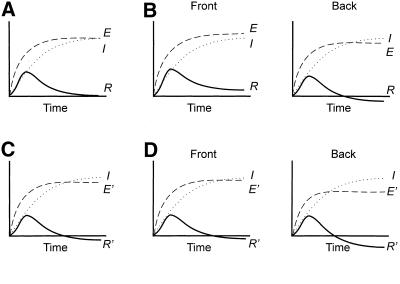Figure 9.
Schematic representation of model for gradient sensing. (A) In wild-type cells, upon an incremental activation, a transient response (R) results from a balance between rapid excitation (E) and slower inhibition processes (I). (B) For a wild-type cell in a chemoattractant gradient, excitation is higher than the inhibition at the front and lower than the inhibition at the back at the steady state. (C) In GγΔ/AX2 cells, the receptor-specified levels of excitation (E′) are lower because less G-protein is on the membrane. On an incremental activation, the response (R′) is slightly impaired. (D) In a chemoattractant gradient, after the initial transient response, the inhibition exceeds the decreased excitation (E′) at the front of the GγΔ/AX2 cells, and gradient is not sensed.

